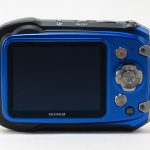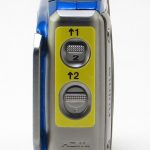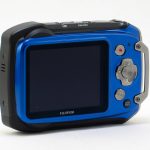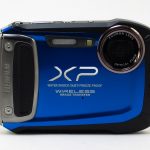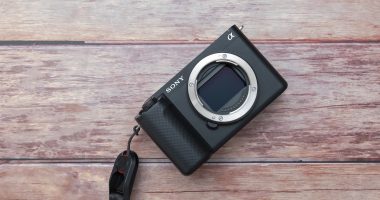Here’s something that usually doesn’t happen but I have in my possession two rugged cameras right now to test out at the very same time. That means that even though each will get their own separate reviews, you’ll be seeing me refer to the other (Panasonic Lumix DMC-TS20) for comparison reasons as well as the PENTAX Optio WG-2 which I looked at a few weeks ago. This new for 2012 rugged camera comes from FujiFilm and it’s the FinePix XP170. The FinePix XP170 is a 14-megapixel camera with 5x optical zoom. It is waterproof up to 32 ft, shockproof up to 6.6 ft, freezeproof up to -10 degrees C, and dustproof. In terms of water depth, it sits between the PENTAX and the Panasonic with the Panasonic unable to go as deep as the other 2. The one thing that this XP170 does have that the other 2 do not is “wireless image transfer” built in. Basically you can transfer images from the camera to a smartphone or tablet wirelessly, but I’ll talk more about that later in the final review.
Exterior
Let’s start this of by saying that what I say about the body of the camera here can also be applied to the FinePix XP150 and XP100. All three cameras have the same body, just different internal features. For this review, FujiFilm sent me the blue FinePix XP170 to test out. The blue body extends from the front to the back and is framed by a huge, black, shockproof bumper. Unlike the WG-2 and the TS20, the XP170 is rather chubby when compared to the others and much taller as well.
 The front on the camera has a very similar layout to that of the Lumix TS20, albeit in a larger package. The XP170 does have a more squarish look to it though looking at it from this angle, you can see that non of the sides are really straight and have a slight curve to them. On the left, you’ll see a rather large hand grip with rubber inserts for grip. On the upper top right is the lens which looks  larger than that of the TS20, but it really isn’t. The lens is surrounded by a gunmetal colored metal ring as part of the design element. To the left of the lens is an LED light that is used as the AF-assist lamp or you can turn it on to help with macro shots and underwater shots. You’ll also find the flash sitting to the left of this light. The rest of the face is slathered in metallic blue paint with a giant XP logo right in the middle of the camera and other text printed underneath it. It’s a bit tacky, but having all this text is a given with most compact cameras these days. The finish on the paint is very glossy and does pick up fingerprints. If you looks closely, you’ll also see the microphone hole under all that text.
The front on the camera has a very similar layout to that of the Lumix TS20, albeit in a larger package. The XP170 does have a more squarish look to it though looking at it from this angle, you can see that non of the sides are really straight and have a slight curve to them. On the left, you’ll see a rather large hand grip with rubber inserts for grip. On the upper top right is the lens which looks  larger than that of the TS20, but it really isn’t. The lens is surrounded by a gunmetal colored metal ring as part of the design element. To the left of the lens is an LED light that is used as the AF-assist lamp or you can turn it on to help with macro shots and underwater shots. You’ll also find the flash sitting to the left of this light. The rest of the face is slathered in metallic blue paint with a giant XP logo right in the middle of the camera and other text printed underneath it. It’s a bit tacky, but having all this text is a given with most compact cameras these days. The finish on the paint is very glossy and does pick up fingerprints. If you looks closely, you’ll also see the microphone hole under all that text.
Turning the XP170 clockwise to the side, you’ll notice there isn’t much here except for the speaker openings. You can see though that the camera does have a bit of thickness to it.
 The rear of the camera is where the action happens. Here is where your eyes and hands will spend most of their time. Most of the rear is occupied by the 2.7-inch, TFT color LCD monitor. That makes it about the same size as the screen on the Lumix TS20. It looks bigger though but that’s mainly due to a slightly thicker bezel. To the right of the screen, you’ll see that that the XP170 has the usual 4-way directional select buttons as well as 1 button at its center. It also looks like it has fewer buttons than that of the PENTAX WG-2 and the TS20, but that’s only because they combined two of the buttons into one and moved the zoom buttons that the other 2 cameras have to the top of the camera as a toggle switch. All the buttons are chrome-look except for the DISP/BACK button which is black for some reason. I do like the dedicated movie record button and having it located near my thumb makes it easier to press when needed. To the right of the buttons is a large bar that you are supposed to attach the hand strap to. The bar is rather large for a regular sized hand strap and I would have rather seen this come with a a larger carabiner like on the WG-2.
The rear of the camera is where the action happens. Here is where your eyes and hands will spend most of their time. Most of the rear is occupied by the 2.7-inch, TFT color LCD monitor. That makes it about the same size as the screen on the Lumix TS20. It looks bigger though but that’s mainly due to a slightly thicker bezel. To the right of the screen, you’ll see that that the XP170 has the usual 4-way directional select buttons as well as 1 button at its center. It also looks like it has fewer buttons than that of the PENTAX WG-2 and the TS20, but that’s only because they combined two of the buttons into one and moved the zoom buttons that the other 2 cameras have to the top of the camera as a toggle switch. All the buttons are chrome-look except for the DISP/BACK button which is black for some reason. I do like the dedicated movie record button and having it located near my thumb makes it easier to press when needed. To the right of the buttons is a large bar that you are supposed to attach the hand strap to. The bar is rather large for a regular sized hand strap and I would have rather seen this come with a a larger carabiner like on the WG-2.
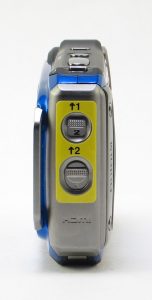 Turning the camera clockwise again, this side of the XP170 is take up by a rather large door. Like the Lumix TS20, the door has a double locking mechanism that is labeled 1 and 2. Don’t mind the sticker in the image as that is something that is supposed to be removed. I left it on to show you the order in which you lock the door. If you notice on the locks themselves, they are also numbered to show you the order in which you unlock the door. The door itself is pretty beefy and takes up the entire side of the camera. Again like the TS20, I like this design much better as it allows you to remove both the battery and SD card from the camera when you have a tripod attached. I also like the fact that there is only 1 door to deal with as opposed to the 2 doors found on the PENTAX WG-2. Behind the door you’ll find the battery, SD Card, USB port and HDMI output port. Again, there is a silicone seal in place that should keep water out of all the vital components.
Turning the camera clockwise again, this side of the XP170 is take up by a rather large door. Like the Lumix TS20, the door has a double locking mechanism that is labeled 1 and 2. Don’t mind the sticker in the image as that is something that is supposed to be removed. I left it on to show you the order in which you lock the door. If you notice on the locks themselves, they are also numbered to show you the order in which you unlock the door. The door itself is pretty beefy and takes up the entire side of the camera. Again like the TS20, I like this design much better as it allows you to remove both the battery and SD card from the camera when you have a tripod attached. I also like the fact that there is only 1 door to deal with as opposed to the 2 doors found on the PENTAX WG-2. Behind the door you’ll find the battery, SD Card, USB port and HDMI output port. Again, there is a silicone seal in place that should keep water out of all the vital components.
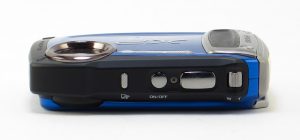 Moving to the top of the camera, you’ll see a couple familiar buttons up here – the on/off button and the shutter release button. Unlike the Lumix TS20, the on/off button here is raised which could cause the camera to accidentally turn on in your pocket or bag. It also doesn’t help that just pressing on the button once will turn the camera on as opposed to having to hold it down for a second or two to do so. The shutter release button is fairly large and easy to press and has a nice feel to it when pressing down. It double clicks, once for focusing and once to engage the shutter. To the right of these buttons is the zoom which is a toggle switch as opposed to the buttons that both the WG-2 and TS20 used on the rear of the camera. I actually prefer the way the XP170 has it here as it makes it much simpler to handle the camera with 1 hand. This keeps your thumb firmly in place allowing for a more secure grip on the camera when using it one handed. To the left of these buttons is the Wireless Image Transfer button. You only need to use this if you are trying to wirelessly transfer images to another device. More on that later.
Moving to the top of the camera, you’ll see a couple familiar buttons up here – the on/off button and the shutter release button. Unlike the Lumix TS20, the on/off button here is raised which could cause the camera to accidentally turn on in your pocket or bag. It also doesn’t help that just pressing on the button once will turn the camera on as opposed to having to hold it down for a second or two to do so. The shutter release button is fairly large and easy to press and has a nice feel to it when pressing down. It double clicks, once for focusing and once to engage the shutter. To the right of these buttons is the zoom which is a toggle switch as opposed to the buttons that both the WG-2 and TS20 used on the rear of the camera. I actually prefer the way the XP170 has it here as it makes it much simpler to handle the camera with 1 hand. This keeps your thumb firmly in place allowing for a more secure grip on the camera when using it one handed. To the left of these buttons is the Wireless Image Transfer button. You only need to use this if you are trying to wirelessly transfer images to another device. More on that later.
The bottom of the XP170 is pretty much like the TS20. Without no door located there anymore, the only other thing down there is the tripod mount which sits almost at the middle of the camera.
Final Thoughts
So with the FujiFilm FinePix XP170, you actually get a rather nice, solid rugged camera that looks like it should be able to take some amount of abuse thanks to that thick shock absorbent bumper surrounding it. This is by far the largest of the rugged cameras I’ve used but at the same time, it’s also the most comfortable to hold in my hand. The large sizing means that even those with large hands will find it comfortable to use. Design wise, it’s neither fancy like the WG-2 or simple looking like the TS20. It has it’s own style that will not be mistaken for any other camera out there.
It’s interesting to note how different camera manufacturers approach making a rugged camera. I mean this is the third rugged camera I’ve used and so far, and all 3 cameras have looked considerably different from one another. I’m eager to see how well the XP170 functions and how good the image quality is considering the fact that so far, the last two FujiFilm cameras I’ve looked at have been pretty good in terms features and image quality and hopefully, the XP170 follows that rend and won’t disappoint me.

